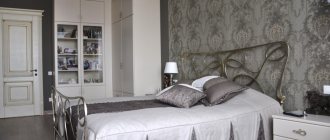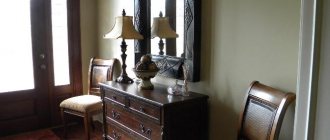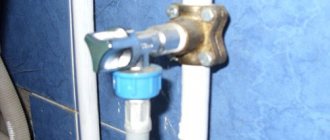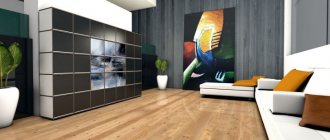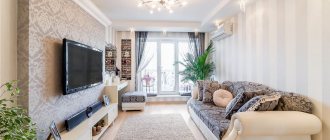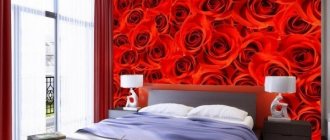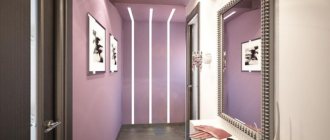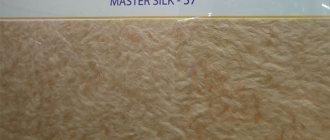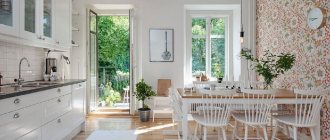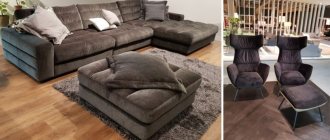Original interior design ideas
To understand how best to decorate a hallway with wallpaper, you can take a closer look at the examples of experienced designers.
In a spacious hallway, paired wallpapers with a beige background and gray leaves are appropriate. It is better to create the layout using a border.
For a narrow corridor, beautiful wallpaper with a natural stone look and a plain companion in the same shade are suitable. Due to the simple design, they will “stretch” the space.
Powdery wallpaper with a simple floral print will look no less harmonious in the long corridor of a Khrushchev building.
Small lace with curls will make the room more spacious, and a mirror and paintings will distract attention from the lack of space
For a private country house with a spacious hallway, bright wallpaper with a large pattern is relevant. They will decorate a bright room, filling it with bright accents.
The design of a hallway with an arch can be done using wallpaper in the form of brickwork, while highlighting the doorway in white.
If the space allows, you can perform a horizontal combination by making original wallpaper panels with a stylish floral pattern in neutral colors.
Beautiful photos of the hallway interior
An entrance hall or corridor, “dressed” in different textured wallpapers, looks elegant and cozy. The uniqueness of the wallpaper lies in the fact that it goes well with white walls.
Colorful and soft contrasts can provide a unique effect:
the hallway and corridor can be decorated with different wallpapers, combining stripes and floral lace in beige shades: an excellent solution for zoning combined rooms using a combination of wallpaper and panels; the design of a bright hallway can be done using paired wallpaper with a lace pattern: due to the interesting texture, the walls do not look boring, and the black accent of contrast will allow you to divert attention from the protrusion of the wall, which reduces the usable area;
- You can make a royal design by combining textured terracotta-colored wallpaper with beige panels: by adding paintings and a gilded mirror to the interior and supporting the idea with wall lamps with gold trim, you can emphasize your special status;
- the original technique of contrasting beige wallpaper with embossing and a photo print with a forest theme in the form of a door will allow you to bring space and warmth into the space, filling the room with a special atmosphere;
- lovers of complex techniques will definitely like the interior composition, which combines horizontal and vertical lines: you can accent a part of the wall by choosing wallpaper to match the color of the floor covering;
- The walls of the hallway can be decorated with striped non-woven wallpaper: canvases with a relief texture placed horizontally are perfect for the columns and ledges of the hallway (for the harmony to be perfect, it is worth supporting the shade of the wallpaper with a rug of a similar color, but with a different simple pattern).
To learn how to hang non-woven wallpaper, see the following video.
Choosing liquid wallpaper for the hallway
First you need to figure out what kind of liquid wallpaper there are. There are four types in total, and each has its own quality characteristics:
- Cellulose liquid wallpaper. The main component of such wallpaper is paper; they are most sensitive to dirt, moisture and even simple touches. Despite the lowest cost among their “brothers”, their use in the corridor is undesirable.
- Silk liquid wallpaper. They are also based on paper, but small threads of silk are added to the composition. This coating is more durable and less sensitive to impacts.
- Textured wallpaper with stone chips. Of the ready-made mixtures, this is the most expensive option, but the use of fine marble in the composition makes such wallpaper stable and durable. This is an ideal option for hallways and other rooms with difficult environments.
- Combined. As a rule, such wallpaper is a homogeneous white mass, into which any components can be added as desired. Most often they are used by professional finishers, since creating a high-quality mixture requires certain skills and knowledge.
The choice of these options largely depends on personal preferences and budget capabilities. In any case, it is advisable to coat the surface of the wallpaper with alkyd or water-based varnishes. This reduces the vapor-permeable qualities of the material, but it creates additional protection from both damage and contamination. In addition, wallpaper with varnish is much easier to clean, and it does not lose color much longer.
The types listed above are the practical side of the issue, but the aesthetics of the hallway are no less important. Liquid wallpaper for the hallway should be chosen based on the individual characteristics of the room. As a rule, a hallway is a small, narrow room without windows, which means it is undesirable to use dark colors in it; they will make the room even smaller and create a gloomy, oppressive feeling.
But it is advisable to avoid too bright shades, as you know, they have the ability to absorb light, and then you can get an intrusive interior in the hallway, from which you want to leave as quickly as possible. A similar feeling is created in subway cars, when too bright light becomes intrusive and unpleasant.
Many designers, when developing the interior of a hallway, use small tricks, for example, you can combine several shades: at the bottom, at a height of about 50 cm, there is dark-colored wallpaper, and then, up to the ceiling, soft light ones. This technique allows you to divert attention from the floor, and the transition between colors visually increases the space.
Best options
In practice, several types of wallpaper have become widespread, each of which has separate characteristics. You need to choose the appropriate option depending on the dimensions of the room, requirements for texture and type of surface.
Glass wallpaper
Fiberglass wallpaper is a material made from impregnated fiberglass. To produce the material, glass blanks are used, which are heated at high temperatures and stretch the fibers. Then they are made into threads and fabric using the weaving method. The coating has a relief structure.
Compared to other finishing materials, fiberglass has a number of advantages. Including:
- environmentally friendly composition that ensures safety for people and pets;
- high levels of strength, resistance to fire and moisture;
- preservation of its original appearance with constant exposure to sunlight and temperature changes;
- Possibility of repeated repainting to change the design.
Liquid
Liquid wallpaper is made from cotton and cellulose fibers mixed with dyes and additional components. This variety differs from classic paper rolls and has more in common with paint in consistency.
Liquid wallpaper is often used in the hallway, since its surface can be easily cleaned with a vacuum cleaner, a damp cloth or a rag. In problematic situations, it is possible to remove the contaminated part with a spatula, after wetting it, and then reapply the solution. The material creates an attractive and natural finish that goes well with natural materials.
Metallized
Metallized wallpaper has several differences in structure, but is in many ways similar to non-woven coverings. A paper sheet or non-woven fabric is used as a base, and the decorative layer is made of aluminum foil.
Pasting with a metallized coating visually adjusts the dimensions of the space. Due to the shiny surface, there is a visual expansion of the area. The material creates an original design and is harmoniously combined with other types of coatings.
Paper
The classic and simplest type is paper wallpaper. They are breathable, environmentally friendly and easy to use. An important comparative advantage is the low cost, thanks to which you can finish the room on a budget.
Textile
Textile coverings consist of a paper or non-woven base, and viscose, linen or cotton fiber is applied as the top layer. In appearance, the material resembles expensive fabrics and gives the room exclusivity and sophistication.
Vinyl
The surface of vinyl wallpaper is quite durable, so they are often used to decorate hallways. The dense texture not only easily withstands external influences, but also hides wall unevenness and prevents the formation of cracks. Non-woven fabric, resistant to rupture and fire, is used as the basis of the material.
Features of liquid wallpaper
Like any other material, liquid wallpaper has a lot of features. They concern not only the methods of their application to the surface, but also the division into types. There are four varieties:
- Cellulose. Made from paper. You can use them to decorate the hallway. However, it is worth remembering that they have a short service life, become dirty and do not tolerate moisture;
The choice depends on each specific room and design idea.
Combination rules
The perception of the interior is determined by the correct choice of wallpaper based on wear resistance characteristics, but not only. The color and texture of the material are important. They always start from the parameters of the room. To achieve a certain perception of the hallway area, it is covered with two or three types of material, combinations of light and dark tones, simple monochromatic and patterned designs are created. When choosing shades to create combinations, they are guided by the location and number of lamps.
In a hallway with non-standard designs: protrusions, niches, decorative arches, they are accentuated with bright colors and stylish patterns.
Popular combination options 2020
As it turns out, there are many combination variations; the main thing is to follow simple principles and not forget that wallpaper should be combined with furniture and interior items. No special skills are needed to create combinations; the whole process is accessible to a beginner in repair. The scope for experimentation is enormous, so any idea has a chance to become a reality. You can combine wallpaper in any appropriate way, the main thing is that the result looks beautiful and harmonious.
There is no clear answer to the question of what is most fashionable in 2020. Timeless classics along with trendy design are still relevant. However, among the trends of the outgoing year, some are still of paramount importance.
We present to your attention the techniques of designers who were most loved in 2020.
The first method is to divide the wall into two horizontal lines. The essence of the method is that light and delicate tones will smoothly flow from top to bottom into a darker and more uniform one. This method involves decorating with borders or moldings.
- The second method is alternating vertical stripes of contrasting colors. Such a room always looks stylish and elegant.
- The third fashionable method is the application of a background pattern and its further decoration. Thus, one section of the wall is emphasized.
- The design of ledges and niches is also one of the favorite trends of recent times. The method is implemented by decorating a bright background, original texture and thereby changing the shape of the hallway.
Liquid wallpaper in the hallway+photo
The hallway is the room where guests constantly visit. It is from the hallway that those who are in your apartment for the first time create an impression of the whole house and its owners (a sample of a decorated hallway in the photo).
Since the hallway is the “calling card” of the entire house, it is important that its decoration is beautiful and functional.
Rules for selecting wallpaper for the hallway
Liquid wallpaper in the corridor began to be used not so long ago. Many homeowners are deterred by their high cost.
Advice! If you decide to decorate the walls of a narrow hallway with liquid wallpaper, choose materials in light colors.
You can achieve the effect of visually expanding the space in the room.
The resulting interior should show harmony between furniture elements, additional accessories, and selected liquid wallpaper. Otherwise, the hallway will have an unpresentable appearance, and it will be difficult to consider it a decoration for your apartment (in the photo there is an option for wall decoration in a narrow hallway).
Wall decoration with wallpaper is still considered one of the most beautiful and original, so it is important to choose the right materials for the hallway. Considering the high traffic flow of this room, to decorate the walls you can use a combination of liquid materials with washable vinyl wallpaper (in the photo - a version of the decorated hallway).
That part of the hallway that is most susceptible to contamination should be covered with washable wallpaper, and the rest of the wall decoration is done with non-washable materials (an example of such a “trick” in the interior is in the photo).
Features of use
In the modern interior of a city apartment, when decorating the walls in the hallway, you can increasingly see liquid wallpaper. In terms of their external characteristics, they are similar to decorative plaster (an example of the use of liquid wallpaper in the interior in the photo).
Attention! When decorating walls, it is advisable to use the services of professionals so that the result will please you and your apartment guests for a long time.
If you do not have the skills to work with these “capricious” finishing materials, immediately look for a real master to decorate the walls. Among the liquid wallpaper (sample in the photo) we note a large color range.
They are offered by manufacturers in a single-color version, but if you wish, you can always choose interesting applications for the walls in the corridor. The use of stencils for liquid wallpaper is also considered an interesting option in the interior, thanks to which the wall decoration takes on a completely different, individual look. With the help of liquid wallpaper you can easily hide minor unevenness, cracks, and increase sound insulation in the room. Due to the fact that when this finishing material is applied to the walls, no joints are visible on the surface, the finish turns out smooth and beautiful (an example of the use of liquid wallpaper in the interior in the photo).
Design techniques
Recently, experienced designers have been trying to combine several options for finishing materials at once when working on projects for hallways. This approach allows you to turn a variety of creative ideas into reality, resulting in an interesting and unusual decoration for a given room (one of these options is pictured in the photo).
For those who decided to paste liquid wallpaper in the hallway on their own, we offer a video fragment
Advice! Do not forget that in the interior of the corridor every little detail is important. In order for your hallway to acquire an aesthetic appearance, you will have to work hard.
About the features of the color scheme
In the interior, color plays a special role. Thanks to it, you can advantageously emphasize the hallway and visually expand it. When thinking over the ideal design (example in the photo), use the tips that experienced craftsmen offer.
In order to make your corridor not only light and spacious, but also practical, try to complement light shades with a dark background, appliqués, and abstract designs. In this case, your hallway will become original, functional, and practical (the photo shows an example of such a solution).
You should not overuse dark colors, as they will introduce a gloomy atmosphere into the corridor and visually reduce its size. In addition to color selection, it is important to correctly use additional lighting fixtures in the corridor. Wall sconces can be placed on opposite walls; in addition, it is advisable to install several spotlights on the ceiling. In this case, liquid wallpaper will look completely different, the corridor will be filled with luxury and harmony. Striped wallpaper gives the corridor an unusual look. To create them you will need a wallpaper mixture of two colors. First, the main tone is applied to the walls using a construction roller or a paint brush.
Attention! It is important to wait until the main tone has completely dried, and only then start decorating the walls with stripes of a different color.
If you have a narrow and long corridor, you need to select liquid wallpaper in soft tones. To expand the space, you can use a horizontal strip along the entire length of the wall.
As a classic option, you can consider a combination of panels with liquid wallpaper. The lower part of the corridor is decorated with panels, the maintenance of which is not particularly difficult. The upper part is decorated with liquid wallpaper.
Advice! To make the created interior beautiful and harmonious, you can choose panels and wallpaper of the same color, but in different shades.
Designers consider the use of appliqués an interesting option. You can choose ready-made pictures at a hardware store or draw your own version of the pattern using a computer program and print it on adhesive paper. With the help of such materials you can get rid of minor imperfections on the walls. For example, you can place small chips or cracks under the applique.
Advantages of using fluid fights in the corridor
Manufacturers offer these finishing materials in a variety of shades. This allows you to profitably use liquid wallpaper when thinking through the interior of the hallway. Flesh colors of the walls help highlight the elements of furniture selected for the corridor. For those who love creative solutions, we suggest trying a combination of different shades and additives in the form of sparkles, rhinestones, and silk. This symbiosis helps to visually increase the space in the room and gives the corridor individuality. When using liquid wallpaper to decorate the walls in the hallway, you will not need to waste time and material resources on carefully preparing the walls for decoration. It is enough to purchase a wallpaper mixture, prepare it in strict accordance with the instructions provided by the manufacturer, and immediately begin repair work. The disadvantage of using such finishing materials is that it will be possible to see the final result of the work done only after the liquid materials have completely dried.
Basic principles of hallway decoration
If you are the owner of a small-sized Khrushchev, do not despair. Using the advice of professional designers, it is quite possible to turn a small corridor into a “calling card” of your apartment on your own. To begin with, it is important to choose the right wallpaper color, think about its texture, and the use of additional decorative elements. In a small corridor, the placement of a huge number of additional items would be inappropriate. It is better to combine liquid wallpaper with washable dense materials in order to get a functional room in addition to a beautiful appearance. Do not forget that the walls in the hallway are often touched with dirty hands. Pets use the walls in the hallway to sharpen their claws. The ideal protection option for this room is a thick layer of paint, but besides practicality, you really want to enjoy beautiful walls! To successfully cope with this difficult task, take a closer look at liquid wallpaper.
These materials will not leave unsightly joints on the surface to be decorated, so you can create beautiful and smooth walls in the hallway without any problems. In addition, you will not have such a problem as the gradual peeling of the wallpaper. Throughout the entire operational period, liquid wallpaper will retain its original aesthetic appearance and will delight you and your guests. If some area on the wall becomes damaged, which is typical for a room such as a hallway, you will not have to completely remove all the finishing materials. It is enough to simply wet the damaged area, remove the damaged wallpaper, and after the wall has completely dried, apply a new layer of the liquid mixture. The cost of such restoration will be significantly lower than purchasing new wallpaper and glue. These finishing materials contain cotton, paper, and silk, so the finished coating is not electrified. Small dust particles will not be attracted to the walls of your corridor. A huge variety of colors, different ways of applying liquid wallpaper to walls, the ability to combine them with other finishing materials, allows you to get an amazing result.
Conclusion
Among the variety of finishing materials that are currently offered by manufacturers on the construction market, a special place belongs to liquid materials. When choosing them to decorate the hallway, take into account the characteristics of their types. Cellulose-based materials are not suitable for a room such as a corridor, as they quickly absorb moisture and dirt. Textured wallpaper with stone chips is the most expensive in price, but it is they that are recognized by professionals as the most durable and resistant. They are ideal for corridors and will help bring the most daring design ideas into reality. For additional protection, they can be coated with a layer of acrylic varnish.
How to combine?
After the choice of wallpaper has been made, gluing begins. But first, you should familiarize yourself with all the nuances of creating a unique design for the hallway area. There are several basic principles of combination.
- You can paste two types of wallpaper, which have different relief patterns;
- Combining smooth wallpaper with wallpaper with a pronounced texture;
- Playing with contrasting shades;
- Using wallpaper of two colors in combination with moldings and frames.
Take into account not only the texture, but also the general surface properties of a particular model. If wallpaper with a glossy surface was chosen for a small corridor, then you need to be prepared for the fact that when you turn on the lighting, glare and reflections will appear that will distort the overall background of the room
Before wallpapering the corridor, apply auxiliary markings so that the result is not marred by inaccuracies and inconsistencies. Markings ensure perfectly even wall covering. Designers adhere to three approaches to combining wallpaper.
- Horizontal;
- Vertical;
- Patchwork.
If the ceilings in your apartment are high enough, a horizontal approach will suit you. It is recommended to cover the bottom area with dark, moisture-resistant wallpaper. Classic requires a light stripe.
Variety of wall panels
Manufacturers of wall panels have taken care to satisfy the tastes of their customers. This finishing material is available in various textures, designs, sizes and colors. Depending on the technical properties and characteristics, wall panels are classified into several subtypes:
- tile panels
In shape, these panels resemble standard ceramic tiles, but on the reverse side they have a tongue-and-groove fastening system. Panels of this type can be used as a single material to decorate the walls in the corridor, or you can combine them with other finishes, creating an interesting design composition. Tile panels are available in various colors and are often decorated with additional finishing.
Panels for walls in the corridor
- slatted panels
The appearance of this material resembles "". There is also a tongue-and-groove system on the back of the panels, which greatly simplifies the installation process. As a rule, the height of the slatted panels ranges from 2.5 to 6 meters, and the width of the products can vary from 10-40cm.
Wall panels for corridor photo
- sheet panels
Panels of this type are monolithic homogeneous sheets, which can additionally be decorated with patterns and designs. This finishing material is ideal for decorating walls of non-standard sizes. In addition, a distinctive feature of sheet panels is that with a flat wall they can be mounted without the use of additional means.
Corridor Wall Panels
Photo wallpaper
Modern technologies make it possible to transfer any image to paper. With the advent of high-quality large-format photo printing, it became possible not to assemble an image from pieces, but to glue it together as a continuous sheet. This looks much better. Photo wallpaper is also used in the hallway.
Photo wallpaper for the corridor: city landscapes are popular, but from different times)))
But, with such a design of the walls, one condition must be observed: everything else is very calm, almost monochrome. The main focus is photography. Otherwise you will end up with something incomprehensible.
Flowers, plants, nature - the second popular motif
General rules for combining
Following the basic principles of combining wallpaper with decorative items, furniture, floor and ceiling coverings allows you to create an attractive design.
Horizontal
The use of plain horizontal stripes when decorating a wall makes the room appear wider. By gluing wallpaper with narrow stripes of non-contrasting shades, you can do without a common background, since this is one of the universal ways to decorate walls.
Vertical
Wide vertical stripes, made in non-contrasting colors, are best used to decorate one wall, where the main attention will be focused. The presence of an accent will add solidity to the overall interior
By combining wallpaper with vertical stripes of different shades, you will be able to realize an original design, which is more typical for creative and extraordinary individuals.
Flaps
When using patches, the surface is covered with different fragments of wallpaper, following the common patchwork design technique. By combining flaps, you can create any shapes on the walls, including waves, zigzags and others.
Inserts
Inserts with drawings of large flowers, landscapes and abstract figures help create an accent on a separate wall. It is also possible to use inserts to decorate niches.
More about liquid wallpaper
Areas of use
The material is ideal for walls and ceilings in children's rooms. With their help you can create interesting paintings in the guest room or hall. Guests will appreciate this covering on the walls in the hallway.
Of course, the material does not like humidity and is used to a limited extent in damp rooms, but after treatment with appropriate compounds, liquid wallpaper works great in such rooms.
Closed loggias and insulated balconies also look special when designed using liquid wallpaper.
What does the material consist of?
In the store, liquid wallpaper is offered in the consistency of a dry mixture of enlarged components, which need to be soaked for some time before application. Next, they are turned into a plastic composition applied to the coating to create the interior.
You can see what the finished materials look like on the wall only in photos of interiors in wallpaper catalogs; for each type of liquid mixture, photos of the final result are created, and the number of components is measured exactly in proportion.
The composition of the dry mixture may include various fibers and materials that are crushed into particles:
- Large and small silk fibers of various shades;
- Cellulose, which is harmless to the human body, lime and cement are used as adhesive materials; binders are not used in the manufacture of liquid wallpaper;
- Plasticizers to facilitate the sliding of the mass along the wall, hardeners and modifiers that increase performance characteristics;
- Fillings made from natural materials, cotton, cotton wool, wool and threads;
- Powdered dyes;
- Decorative additives in the form of crushed sparkles, mica, mineral particles, mother-of-pearl and others. Combinations of various additives and dyes make it possible to create a variety of types of finished wall and ceiling coverings;
- Additives that allow you to protect the natural components of the finishing material from the settlement of microorganisms and fungal growth.
What types of wallpaper are there?
Today, the building materials market is replete with a variety of assortments, so there are no problems with the availability of materials. But a large selection will definitely make those who don’t have a clear idea in their head of what they want confused. The most worthy and proven types of wallpaper today are listed below.
Vinyl wallpaper is very easy to use, not prone to fading, abrasion, and easy to clean. Such wallpaper easily masks uneven walls. Easy to combine. They come in both thick and thin;
- Acrylic wallpaper is slightly less wear-resistant, but is impervious to moisture. They are pleasant to the touch, have a velvety texture and can be perfectly combined with other types of wallpaper. When cleaning this type of wallpaper, do not use detergents or hard brushes;
- Non-woven wallpaper is very durable and resistant to external influences. They are not environmentally friendly, but they can easily withstand repainting several times when you want a change;
- Fiberglass wallpaper is a natural version of washable wallpaper. In addition, they contain components that prevent the formation of mold. Fiberglass wallpaper can also easily withstand repainting;
- Liquid wallpaper is a special plaster that is perfect for the corridor. They combine well and are environmentally friendly. Allows you to create unusual patterns and transitions.
- Metal wallpaper is a relatively new phenomenon in the world of building materials. They have a thin foil coating. Their cost is very high due to spraying or hand painting. As a rule, they are made in dark colors.
- Cork wallpaper is a natural and environmentally friendly option. They have a thin wax coating, are moisture resistant, and have a soundproofing function, but their color palette is not very rich.
Wall decoration with liquid wallpaper: advantages
One of the main attractive factors is the lack of seams. Paper wallpaper has joints. Liquid wallpaper is applied according to the principle of decorative plaster, so the entire wall will be a single canvas.
The advantages also include:
- Natural wallpaper. They are made from environmentally friendly materials, cotton or cellulose, which is important if there are small children in the house, or, especially, those with allergies.
- Possibility of partial repair. The same kid ruined the wallpaper, part of the layer is removed, a new one is applied - there will be no noticeable difference.
- Elimination of minor defects. Of course, liquid wallpaper itself will not remove small unevenness in the wall, but it will definitely disguise them.
- Possibility of coloring. First, you add the desired color to the composition, and then, as necessary, the wallpaper can be repainted directly on the wall.
Well, how can we not say that liquid wallpaper does not attract dust!
That is, no special care is required for the wall.
The thermal insulation characteristics of the material are also good, the surface of the walls will be warm.
Principles of arranging hallways
In order for such wishes to be realized in practice in a specific hallway volume, you need to correctly combine, combine the features of wallpaper and this or that furniture.
To do this, you need to take into account a number of the following factors in order to know exactly what wallpaper to choose for the hallway:
Area and design features of the hallway; The height of the hallway walls (important for future design); The quality of wall surfaces (this affects the selection of a particular material for wallpaper); Factor in the natural level of light (for example, a glossy wall is not suitable for narrow corridors without natural light); What is the percentage of probability in terms of any contamination of the wallpaper; Stylistic features of this or that furniture that affect the overall comfort of the room.
Today here is a unique opportunity to consider the most current modern wallpaper for the hallway in an apartment, which is currently presented on the domestic market, to learn about what wallpaper to choose for a hallway of even a small size.
Vertical or horizontal?
When making such a choice, it is important to know some of the nuances that they introduce into our character of perception of a particular room:
- vertical - make the corridor more symmetrical and tall;
- horizontal - expand the space and visually lower the ceiling slightly lower.
Of course, any change in height and width is nothing more than an illusion of human perception, but it directly affects how a person will see his corridor in the end.
Here is a vivid example of how high a corridor covered with vertical wallpaper appears
And in this case, horizontal wallpaper expands the distance between the walls and helps achieve optimal visual comfort for the owners of the room
Let's look at some more examples of this type.
As you can see, even the most unfriendly and wide corridor can be made warm and cozy if you successfully select wallpaper and some remarkable interior details.
And again, horizontal stripes come to the rescue - it’s hard to deny this room’s atmosphere and harmony.
Real mansions, not an apartment. However, every square meter of space is used as successfully as possible. Including walls with spectacular vertical stripes and abstract patterns. Decorative Venetian plaster was used to match the wallpaper.
Notice how high the ceilings seem. This is largely due to wallpaper with vertical stripes.
Kinds
Wallpaper is an internal finishing building material for cladding walls and ceilings, which is presented on the modern construction market in the form of rolls. Thanks to unique modern developments using special technologies, the choice of raw materials has no limits. Today, this decoration is fundamentally different from its Soviet-era counterpart: it is a design tool that sets the idea of interior composition.
In terms of importance, wallpaper is comparable to hallway lighting, which can complement any interior, filling the room with light. All types of wallpaper for the hallway can be divided into several varieties, among which the main ones are those listed below.
Paper
Paper varieties are smooth or structured paper sheets of different widths with an image or photo printing applied to the front side. Depending on the category, they can be single-layer (simplex) or double-layer (duplex), while single-layer ones are less wear-resistant and less expensive, while double-layer ones are more attractive and can decorate the surface of the hallway walls for 5 years without the need for re-gluing.
Vinyl
Vinyl wallpaper has a porous surface and consists of two layers: an upper vinyl layer and a lower base layer, which is a paper or non-woven backing covered with PVC film. The material belongs to the class of elite finishing, although it does not allow air to pass through well and over time can emit formaldehyde fumes. Vinyl wallpapers are divided into several varieties: silk-screened, smooth, hard and foam. The design is applied by embossing and often resembles textiles in appearance.
Textile
Textile wallpaper is a decorative fabric or individual threads located parallel to each other and glued to a paper base. This finishing is a sign of good taste and well-being of the owners of the house, although such material is quite capricious in care and operation and requires special pasting skills. To prevent glue from getting on the front side, you have to apply it to the wall; fortunately, the non-woven backing provides for this.
Non-woven
The non-woven finish is distinguished by a dense polymer backing made of paper or textile fibers. This material has excellent air permeability, is easy to work with, fire-resistant, does not fade if the hallway is properly lit and, if necessary, can hide minor unevenness in the walls. The disadvantage of this wallpaper is the accumulation of dust on the surface; in addition, this coating requires careful handling.
For painting
Paintable varieties are an excellent option for hallway wall coverings. If necessary, they can be repainted in any color. They are unpretentious in preparing walls, are a waterproof material and require repeated painting of the surface, evenly filling each area of the textured surface with fresh paint.
Liquid
Liquid wallpaper is a unique way to introduce a new idea into a room by gluing individual pieces of material, which is mixed according to the principle of wallpaper glue and allowed to set for a specified time. Essentially, this is a material that is applied to the wall without joints, smeared over the surface of the wall and, if desired, made into any pattern. Wallpaper takes a very long time to dry and suffers from water getting on it. This type is not rolled.
To learn how to create a pattern with liquid wallpaper, see the following video.
Glass wallpaper
Glass wallpaper is an original hallway design technique. This is a fiberglass wall decorative covering that is made using the weaving method. The material is knitted from glass fibers, giving a stable shape through special impregnations. This includes matting, which is capable of reinforcing walls, masking even cracks in them. This wallpaper is non-toxic, rot-resistant, and has an affordable price.
3D
3D wall coverings include wallpaper on which a digital image is applied, distorting space and creating a three-dimensional three-dimensional effect. Such canvases are quite expensive, easy to use, resistant to mechanical damage, and fireproof. Their only drawback is that they get boring quickly and require a long distance for the correct effect.
In addition to the main varieties, there are other design techniques. Trademarks offer creative buyers rare and exclusive materials, among which velor, linen, bamboo, metallized, cork, jute, fluorescent, luminous wallpaper and superwash stand out, but not all of these varieties are practical in the hallway and suitable for its design.
Which liquid wallpaper is better to choose for the hallway with your own hands?
Stage No. 1 The hallway is prepared in the same way as for plastering with decorative mixtures (the furniture is taken out, the trim is sealed, the door panels and floors are protected, and the sockets and switches are de-energized). Ceilings and walls are cleaned of whitewash, loose paint, unusable, fragile plaster, and stains. Smooth out chips and large differences with putty. Prime with 2-3 layers. Dry it.
Stage No. 2
Prepare the dough with a reserve. Pack it tightly, hermetically, transfer the resulting dough into a plastic bag. Stir only with your palms, kneading the lumps, pour the dry mixtures (the entire contents of the package) into warm water. The packaging is left for the glue to swell completely (at least 8 hours).
If one package is not enough, then after sealing the first batch, mix the second and third. They seal it, let it ripen, and mix the whole mass from the batches together. In this way, they achieve the required amount of dough of the same color. Liquid wallpaper is tinted by taking the required amount of dough to create a multi-colored pattern.
Stage No. 3 Liquid wallpaper
Apply by spreading using a spatula, grater or trowel. The mass can be applied in a layer of up to 10 mm, but a layer of 2-3 mm will stick to the wall more firmly. For professionals, a layer of 1.5-2 mm is applied. During work, long breaks are not allowed to prevent visible joints from forming. Dry for up to 3 days, after which it can be varnished. Stage No. 4 (Creating a pattern)
Drawings and patterns are made in different ways. For stencil technology, dough of appropriate colors is prepared. Stencils are often used. The stencil is attached to the wall, a pattern is applied with it. The mass is allowed to dry, after which the carved device is removed.
They protect it from getting dough of a different color. Free areas are filled with a mass of a different color using a narrow spatula. There is also another method, when a mass of a different tone is applied using a stencil on top of an evenly laid, dried phoram solution.
If the drawing is simple, draw boundaries on the wall with a pencil. Filling the entire area, paste the mass inside the lines. The adjacent sections of the wall are sealed with masking tape so as not to get dirty. Remove the tape and dry the pasted dough. Then the colored solution is applied to adjacent areas.
You can make modeling from liquid wallpaper dough. For such decoration, the mixture is diluted thicker. For shaping, you can also use various objects (spoons, knives, scrapers), you can sculpt directly with your hands.
Textured patterns can be applied with a rubber or plastic roller. Soak and mix or shift to some extent, at the same time the underlying layer can absorb water. It can be applied with a brush, drawing on top of the background, if the dry mixture is diluted thinner and tinted. Therefore, it will be correct to practice on a sampler.
Correct combination of wallpaper
By introducing beautiful combinations of wallpaper, you can create interesting compositions in the hallway, as well as correct shortcomings in the geometry of the room. The simplest option is to combine plain coatings with each other or alternate them with patterned ones, adhering to a similar color palette. It is a little more difficult to experiment with patterns, where not every print will “gladly” accept a contradictory pattern. Try to design a duet from a strict check, combining it with striped wallpaper - you will notice how the perception of space will change. The same effect can be achieved by combining elegant floral prints and abstract designs. In a spacious hallway, you can combine rich and light shades of wallpaper, placing them in horizontal or vertical planes. For a narrow hall, a good solution would be to decorate two opposite walls with contrasting canvases. And in a small hallway you can increase the width and height by combining light and dark wallpaper in the appropriate directions.
Wallpaper for hallways with different parameters
Sometimes it can be difficult to decide which wallpaper in the hallway will help highlight the advantages and disguise the shortcomings of this room. In addition, in many respects this effect depends not on the design of the wallpaper for the walls, but on the characteristics of their gluing in a limited space.
Let's figure out how to solve three main problems typical for such interiors: poor lighting, cramped space and disproportionate shapes.
A hallway with insufficient lighting will not be perceived as stylish if you cannot emphasize bright accents in the space.
To make individual decorative elements look more expressive, create a light background on the walls. This wall decoration will make the hallway interior brighter and more spacious.
What wallpaper is best for a compact hallway? If there is not enough free space in this room, correct this deficiency with the help of visual effects: in addition to light wallpaper for the walls, patterned wallpaper with images that change the space will suit you. For example, vertical striped wallpaper will raise the ceiling level, and horizontal lines on the walls will visually increase their width.
For cramped hallways, wallpaper with small patterns, as well as plain coverings made in cool colors, are suitable. Using wallpaper with opposite shades and patterns, you can make a hallway with an overly large area more comfortable.
Quite often, the hallway is not only limited in size, but also has an elongated shape, which does not allow the implementation of many interesting approaches to decoration. Contrasting combinations will help transform such an interior: dark wallpaper for long hallways, pasted on wide walls, will visually distance them and reduce them in size.
Another option for correcting the shape of a narrow hallway is to divide the room into two zones. The walls near the front door are decorated in one color scheme, and the distant areas of the room are decorated in other shades. To make such an interior look harmonious, use colors that are similar in tone.
Tip: you can use moldings to separate zones and disguise transitions between shades. The use of moldings in design is more typical of ancient trends, but they are becoming increasingly popular in modern hallways.
Of course, the presented examples of interiors will tell you what wallpaper to choose for the hallway. But, while observing the described principles for choosing finishing materials, you should not forget about your own tastes.
In the hallway, like in any other room, every member of your family should feel comfortable. So plan your wall design together.
About what wallpaper is best to glue in the hallway, see the video below:
https://www.youtube.com/watch?v=3BHKu9qPpQk
How to choose wallpaper for the hallway
This part of the apartment is the border between the house and the street. The way the hallway looks determines what mood you will be in when you leave the house and how you will feel when you return to it. There are some factors by which you need to choose wallpaper for the hallway.
By color
When choosing colors, you need to take into account that cold blue, green, light green, gray colors expand the space, and warm yellow, orange, red and their shades narrow it.
It’s unpleasant to find yourself after a bright sunny day in a dark, narrow hallway covered with the same wallpaper. Or, conversely, find yourself in a blinding, oversaturated room with colors.
Saturated deep colors on well-lit walls will irritate and tire the eyes, but they are well suited in small quantities for finishing and zoning space. If you decorate the lightest wall with such wallpaper in contrast, it will absorb some of the light and calm the eye.
For bright hallways, it is recommended to take canvases of soft shades in cool tones, for example, beige, light green, soft green, blue, yellow-blue, pale pink. For dark ones - light warm shades, such as peach, cream, golden, yellow-green.
According to the drawing
The ornament on the walls in the hallway should not stand out from the overall composition, but form a single whole with other interior elements. Small discreet flowers arranged in small segments, small spots of similar shades chaotically scattered across the canvas, blurred horizontal or vertical stripes - such a background will advantageously highlight stylish cabinets, original doors or luxurious flooring. But if the hallway is not burdened with furniture, then you can focus on a large, interesting pattern on the wallpaper.
And, of course, you need to take into account the shape and lighting of the hallway.
If paintings, mirrors, wall clocks or other accessories are planned on the walls, then in this case it is better to make the walls plain to avoid variegation and overload with color.
By invoice
When choosing textured wallpaper for painting, the same recommendations are taken into account as for wallpaper with a pattern. The relief on the canvases can be large, small, imitating crumpled paper, large cracks, geometric or floral patterns. The pattern can be clearly repeated or have randomly scattered bumps.
The larger the textured segments, the more clearly and brightly they will stand out on the wall, and good lighting will add volume. Accordingly, a large relief will narrow the room, and a small one will expand it.
Smooth wallpaper has its advantages; it is easier to paint it to match furniture, accessories, doors, or tint it with the main shades that predominate in the interior.
Combined wallpaper
Combination is the use of several types of wallpaper in the interior of one room. Wallpaper for combining can be either matched in color, pattern, texture, or completely different. It all depends on the problems that you want to solve with this design technique.
Many manufacturers create special collections in which you can choose 2-3 types of wallpaper specially selected for combination. Such collections are called companion wallpapers. They may differ in tone or texture, but they will definitely have common design elements and be similar.
The most popular combinations of wallpaper companions:
- wallpapers differing from each other by 1-2 tones;
- wallpaper with the same color, but different texture;
- wallpaper with the same texture and color, but different patterns;
- Wallpaper with the same texture and pattern, but different in color.
Typically, combining wallpaper is used for zoning or visual correction of room imperfections.
Zoning for this room is, of course, also possible, and it does not have to be a huge hallway, but what comes to the fore is the visual correction of the room’s shortcomings.
One of the main disadvantages of most hallways is their small size. If we use wallpaper in dark colors in the area of the front door, and light shades in the rest of the hallway, we will get a visual increase in the hallway.
You can create the illusion of space by combining wallpaper with a horizontal pattern with textured wallpaper.
By combining wallpaper in a vertical pattern with plain, smooth wallpaper, you can visually “raise the ceiling.”
Only a small part of this article is devoted to the combination of different types of wallpaper. Our article about combining wallpaper in the living room will tell you more.
A hanger is a must-have attribute of any hallway. Our article will help you choose it.
Cassette ceiling in your hallway - https://flaterra.ru/prihozhaya/dizain-p/reechnye-i-modulnye-potolki.html.
Types of modern wallpaper
The most durable are vinyl wallpapers. Using these materials you can hide minor flaws in the walls. They are quite dense, their service life is up to 20 years.
Paper wallpaper is the cheapest, so if you want to change the wall decoration often, choose these materials.
Modern textile finishing materials are two-layer, decorative, and have a thermal insulation function.
Non-woven fabrics can be repainted; they are a durable and practical finishing material and are used in fire-hazardous buildings.
Bamboo wallpaper is an environmentally friendly, light-colored finishing material. Light-colored materials predominate.
How to glue it correctly
- Wallpaper is selected according to thickness, wall imperfections are masked with relief coatings.
- To maintain vertical and horizontal lines, markings are first applied.
- The main canvas is placed on the wall first.
- To emphasize certain areas and disguise seams, wallpaper edging, moldings are used, and designers’ ideas with planks and borders are used.
- At the junctions of two types of wallpaper, make sure that the glue does not leave marks on previously glued fragments.
Choice depending on the shape and area of the room
In buildings dating back to Soviet times, where the area of the room at the entrance leaves much to be desired, before renovation it is necessary to think through all the nuances so that as a result the space gives energy to those leaving and inspires them to do household chores when they arrive.
Wallpaper design for a narrow hallway
In rooms where the usable area is very small, the defects of a long “tunnel” are corrected with a thoughtful design. Key points to remember:
- They don’t use black or dark blue; brown is harmful; with them the corridor will become even narrower.
- Light shades are preferable, but the interior should not be associated with the interior of the carriage.
- Bright colors in moderation.
- The space where combination is used seems more spacious.
- Use neutral patterns and striped wallpaper to make the room different from others.
- A coating of pastel colors with dark veins in the pattern will hide possible stains and scuffs.
- Large drawing is contraindicated.
Wallpaper design in a small hallway
Any wallpaper is chosen here, as long as it does not visually make the room smaller. If, in addition to a small area, the room has low walls, they are decorated with vertical striped wallpaper. You should not narrow the space by decorating the walls with brick and stone. If the owners like natural materials, they resort to imitations of them, buying matting, burlap, and bamboo finishes. In this case, choose lighter shades so as not to weigh down the interior.
For a small hallway it is important:
- A room in warm colors will visually narrow, while cool colors will expand it.
- A large pattern makes the room smaller; a small pattern will help move the walls apart.
- The surface of the walls should be matte, without reliefs or complex ornaments.
Wallpaper design in a spacious hallway
In a spacious room of a private house, dark and bright colors and contrasts are acceptable. If you stop at a light background, then the feeling of spaciousness can be muted with a large, expressive print. You just need to find a balance between the volume of the hallway and the visual effect you are striving for.
Wallpaper with the effect of wood, brickwork, and cork are most appropriate in a large room. The ability of such a coating to hide extra square meters will be useful. In free space, styles such as avant-garde and modern find freedom for the designer’s imagination. Paintings and family photos are hung on empty spaces on the walls.
Types of wallpaper
As you can see in the photo of wallpaper for the hallway, the most popular options are:
Paper. They belong to economy class. Can be with a drawing or photo printing. They come in different thicknesses. They are divided into two types - single-layer and double-layer. The downside is low moisture resistance.
Vinyl. Characterized by a porous texture. Disadvantages: they emit formaldehyde and are unreasonably expensive.
Non-woven. They have sufficient density. Breathable. Other advantages are fire resistance, resistance to sunlight, and the ability to hide minor surface defects. Disadvantages – they accumulate dust and require careful handling.
Textile. Similar to a decorative covering with woven threads. Plus – pretentiousness. The downside is capriciousness.
Quite popular today is the idea of wallpaper for the hallway to be painted.
Photo wallpaper is an ideal wallpaper option for a small hallway, as it can visually enlarge the space. With their help you can create a truly unique interior.
It is also worth saying a few words about this type of modern wallpaper for the hallway, like liquid wallpaper. They appeared on the construction market recently, but have already found their fans. This is the only type of wallpaper that is available in packages.
A fashionable trend is the use of natural wall coverings - bamboo, cork, jute. They have one single drawback - high cost.
But they have a lot of advantages - environmental friendliness, unique texture, moisture resistance, aesthetics.
It is also worth noting two types: glass wallpaper and cladding with a 3D effect. The former are a unique material with a glassy texture, are resistant to rotting, are affordable, non-toxic, and can be painted.
The peculiarity of the second is a three-dimensional image. 3D wallpaper is characterized by: resistance to mechanical damage, non-flammability, high quality pasting. The disadvantage is the space requirement.
Design solutions with liquid wallpaper in the living room
Where you can definitely go wild using liquid wallpaper is in the living room. You can choose any style, any color and design.
Advantages of using liquid wallpaper in the living room:
- If the living room is large, you can impress with the texture of rich colors;
- If the living room is small, use light liquid wallpaper - it turns out to be more spacious visually, and warm and cozy;
- In different lighting conditions, the wallpaper will look different, and given the system lighting of modern living rooms, when you can either dim it or make it brighter, this is another plus.
If you use plasterboard structures in the living room, then you should not be afraid that the liquid wallpaper will not adhere to this material - it will, and even easily and well.
